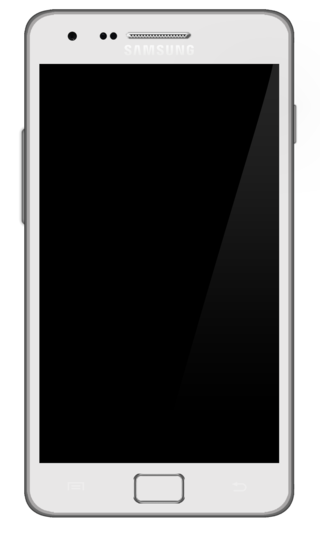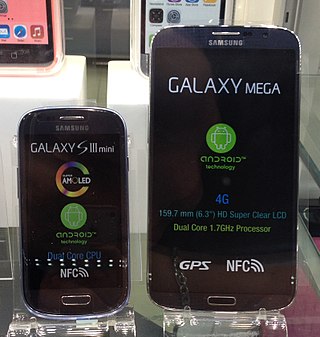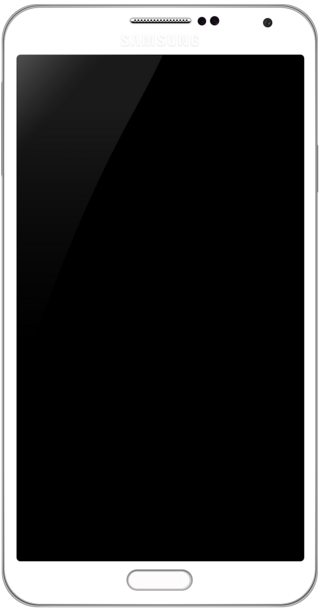Related Research Articles

The Samsung Galaxy S II is a touchscreen-enabled, slate-format Android smartphone designed, developed, and marketed by Samsung Electronics, as the second smartphone of the Samsung Galaxy S series. It has additional software features, expanded hardware, and a redesigned physique compared to its predecessor, the Samsung Galaxy S. The S II was launched with Android 2.3.4 "Gingerbread", with updates to Android 4.1.2 "Jelly Bean".

The Samsung Galaxy S III is an Android smartphone designed, developed, and marketed by Samsung Electronics. Launched in 2012, it had sold more than 80 million units overall, making it the most sold phone in the S series. It is the third smartphone in the Samsung Galaxy S series.

Samsung Galaxy Y (GT-S5360) is an Android-based smartphone by Samsung, announced in August 2011. Its main features are 3G connection with speeds up to 7.2 Mbit/s and Wi-Fi.

The Sony Xperia S is an Android smartphone from Sony launched at the 2012 Consumer Electronics Show. It is the first Sony-only branded smartphone after Sony acquired Ericsson's stake in Sony Ericsson in January 2012. The Xperia S has a 4.3 in (110 mm) touch-screen with the mobile BRAVIA engine which optimizes the picture, a 1.5 GHz dual core processor, a 12.0-megapixel rear camera, HDMI-out, 1 GB of RAM, and 32 GB of internal storage.

The Samsung Galaxy S series is a line of high-end Android smartphones produced by Samsung Electronics. Together with the foldable Galaxy Fold and the now discontinued Galaxy Note series, the lineup serves as Samsung's flagship smartphone lineup.

The Samsung Galaxy S III Mini is a touchscreen-based, slate-sized smartphone designed and manufactured by Samsung. It was announced in October 2012 and released in November 2012. The Galaxy S III Mini technological specifications include a 4-inch Super AMOLED display, a dual-core processor running at 1 GHz with 1 GB of RAM, a 5-megapixel rear camera, and a front-facing VGA camera for video calls or selfies.

The Samsung Galaxy S4 is an Android smartphone produced by Samsung Electronics as the fourth smartphone of the Samsung Galaxy S series and was first shown publicly on March 14, 2013, at Samsung Mobile Unpacked in New York City. It is the successor to the Galaxy S III, which maintains a similar design, but with upgraded hardware, more sensors, and an increased focus on software features that take advantage of its hardware capabilities—such as the ability to detect when a finger is hovered over the screen, and expanded eye tracking functionality, it was released the previous year. A hardware variant of the S4 became the first smartphone to support the emerging LTE Advanced mobile network standard. The T-Mobile version of the Galaxy S4, named the model (SGH-M919), was released the same month. The phone's successor, the Samsung Galaxy S5, was released the next year.

The Samsung Galaxy Grand is a smartphone developed by Samsung Electronics, first announced on December 18, 2012. The phone has a dual core Cortex-A9 1.2 GHz processor and a RAM of 1 GB, with an internal memory of 8 GB which can be extended to another 64 GB by use of microSD cards. The device also supports internet connectivity through 2G and 3G, apart from Wi-Fi. Navigation systems including A-GPS and GLONASS with Google Maps. The phone runs on the Android 4.1.2 Jelly Bean OS, with Samsung releasing updates up to 4.2.2. However, custom ROMs are available up to Android 7.1.2 Nougat.

The Samsung Galaxy Mega is an Android-based phablet that was manufactured and released by Samsung. It was announced on April 11, 2013. The original model featured a 6.3 in (160 mm) screen, though a revised version was released with a 5.8 in (150 mm) screen. It has a 1,280×720 screen, a dual-core 1.7 GHz processor and an 8-megapixel camera. The phone runs Android 4.2.2 "Jelly Bean" software, and internal storage is 8 or 16 GB.

The Samsung Galaxy Note 3 is an Android phablet smartphone produced by Samsung Electronics as part of the Samsung Galaxy Note series. The Galaxy Note 3 was unveiled on September 4, 2013, with its worldwide release beginning later in the month. Serving as a successor to the Galaxy Note II, the Note 3 was designed to have a lighter, more upscale design than previous iterations of the Galaxy Note series, and to expand upon the stylus and multitasking-oriented functionality in its software—which includes a new pie menu opened through the button on the stylus for quick access to pen-enabled apps, along with pop-up apps and expanded multi-window functionality. It additionally features new sensors, a USB 3.0 port, 3 GB of RAM, and its video camera has been upgraded to 2160p (4K) resolution and doubled framerate of 60 at 1080p, placing it among the earliest smartphones to be equipped with any of these.

The Samsung Galaxy Star is a low-end smartphone manufactured by Samsung Electronics. It is running on Android 4.1.2(Jelly Bean). It has unofficial Android 4.4, 5.1, 6.0.1 and 7.1 roms. It was announced in April 2013, it was subsequently released in May 2013. It is the cheapest smartphone in the Samsung Galaxy series. Like all other Samsung Galaxy smartphones, the Galaxy Star runs on the Android mobile operating system. The phone is available in 2 versions: a single SIM version (GT-S5280) and a dual SIM version (GT-S5282). The phone competes with other low-cost smartphones such as the smartphones from the Nokia Asha series as well as low-cost smartphones manufactured by Indian manufacturers such as Micromax, Karbonn, Spice Digital, Lava International and Celkon. It is available in certain Asian countries such as India, Pakistan, Sri Lanka, Nepal, Bangladesh, Myanmar, Philippines, Indonesia etc. where low-cost smartphones are very popular as well as in Morocco, Algeria, South Africa, Portugal, France, Germany, Russia and Ukraine. Brazilian version is also released, dubbed GT-S5283B.

Sony Xperia L (C2104/C2105) is a Sony's budget oriented smartphone manufactured by Sony, announced in March 2013 and launched in May 2013.
The Samsung Galaxy Pocket Neo is an Android smartphone manufactured by Samsung. It was announced in March 2013 and released in May 2013 as the successor to the Samsung Galaxy Pocket Plus. The handset is still budget-oriented, sporting a larger 3-inch display. Its specifications are similar to that of the Samsung Galaxy Pocket Plus, with only minor upgrades such as the Android 4.1.2 Jelly Bean operating system and the display size. The Samsung Galaxy Pocket Neo, like its predecessors, is still marketed as "Pocket Friendly," because it can be slipped inside pockets easily despite the larger size.
The Samsung Galaxy Express 2 (SM-G3815) is a smartphone made by Samsung which was launched in October 2013 featuring a similar design and specifications of the Samsung Galaxy S4 Mini but with a bigger 4.5 inch screen and different cameras.

The Samsung Galaxy S6 is a line of Android-based smartphones manufactured, released and marketed by Samsung Electronics. Succeeding the Samsung Galaxy S5, the S6 was not released as a singular model, but instead in two variations unveiled and marketed together—the Galaxy S6 and Galaxy S6 Edge—with the latter differentiated primarily by having a display that is wrapped along the sides of the device. The S6 and S6 Edge were unveiled on March 1, 2015, during the Samsung Unpacked press event at MWC Barcelona, and released April 10, 2015, marking a counter-utilitarian and fashion-oriented course in the Galaxy S series. During the subsequent Samsung Unpacked event on August 13, 2015, Samsung unveiled a third model, the Galaxy S6 Edge+, which features a larger phablet-sized display and more memory, but lacks an infrared transmitter used for remote controlling.

Nexus 6P is an Android smartphone developed and marketed by Google and manufactured by Huawei. It succeeded the Nexus 6 as the flagship device of the Nexus line of Android devices by Google. Officially unveiled on 29 September 2015 along with the Nexus 5X at the Google Nexus 2015 press event held in San Francisco, it was made available for pre-order on the same day in United States, United Kingdom, Ireland, and Japan.

The Phab 2 Pro is an Android smartphone in a phablet form factor, developed and produced by Lenovo and first released in November of 2016 at an MSRP of US$499. The device is notable for being the first consumer smartphone to support Google Tango augmented reality (AR) technology.

The Samsung Galaxy Note 8 is an Android-based smartphone phablet designed, developed, produced and marketed by Samsung Electronics. The successor to the discontinued Samsung Galaxy Note 7, Samsung Galaxy Note Fan Edition and Samsung Galaxy Note 5, it was unveiled on 23 August 2017 and became available on 15 September 2017.

The Samsung Galaxy A90 5G is an Android phablet manufactured by Samsung Electronics as part of its fifth-generation Galaxy A series lineup. It comes with Android 9 (Pie) with Samsung's One UI skin, 6/8GB RAM, 128 GB of internal storage, and a 4500 mAh battery. It is Samsung's first mid-range smartphone to support 5G network connectivity. The Galaxy A90 5G was first unveiled in South Korea on September 3, 2019.

The Samsung Galaxy M30s is an Android phablet manufactured by Samsung Electronics as part of its first-generation Galaxy M series lineup, as a successor to the Samsung Galaxy M30. The phone is shipped with Android 9 (Pie), Samsung's proprietary One UI skin, 64 or 128 GB of internal storage, and a 6000 mAh Li-Po battery. The M30s was released on 18 September 2019. It features a rear triple camera array composing of a 48 MP wide angle camera, 8 MP ultra wide angle camera, and a 5 MP depth sensor.
References
- ↑ Ziegler, Chris (2011-12-07). "Android: A visual history". The Verge . Vox Media. Archived from the original on 2012-06-23. Retrieved 16 June 2012.
- ↑ Elgin, Ben (August 17, 2005). "Google Buys Android for Its Mobile Arsenal". Bloomberg Businessweek. Bloomberg. Archived from the original on February 27, 2011. Retrieved 2012-02-20.
- 1 2 3 4 Solomon, Kate (29 January 2013). "Samsung Galaxy Express launches, bringing 4G for less". TechRadar . Retrieved 7 November 2013.
- 1 2 3 4 "GALAXY Express – Tech Specs". Samsung Australia. Retrieved 6 November 2013.
- ↑ "Play everywhere you go" . Retrieved 6 July 2012.
- ↑ Sandle, Paul (29 May 2012). "Samsung boosts Galaxy appeal with Music Hub". Reuters . Thomson Reuters . Retrieved 8 August 2012.
- 1 2 La, Lynn (13 December 2012). "Samsung Galaxy Express Review:Packs the midlevel goods at the right price". CNET . CBS Interactive . Retrieved 7 November 2013.





- ↑ "Samsung Galaxy Express review: Jelly Bean Express". Gsmarena.com. 2013-02-20. Retrieved 2013-11-07.
- ↑ "Samsung Galaxy Express I8730". Gsmarena.com. Retrieved 2013-11-07.
- ↑ Trenholm, Richard (13 June 2012). "Samsung Tectiles NFC stickers control your phone with a tap". CNET . CBS Interactive. Archived from the original on 16 June 2012. Retrieved 7 November 2013.